New Listings April 8
These are the most recent New Listings as buyers and sellers are making creative arrangements for viewing:

Marblehead New Listings
Swampscott New Listings
Salem New Listings
Beverly New Listings
Lynn New Listings
A Calmer Mortgage Market
Recession and Recovery
Andrew Oliver
Market Analyst | Team Harborside | teamharborside.com
REALTOR®
Sagan Harborside Sotheby’s International Realty
One Essex Street | Marblehead, MA 01945
m 617.834.8205
www.OliverReports.com
[email protected]
Sotheby’s International Realty® is a registered trademark licensed to Sotheby’s International Realty Affiliates LLC. Each Office Is Independently Owned and Operated
List of all currently available properties
As there are no Open Houses currently, I am replacing the normal Open House post with one showing details of all houses and condos currently available for sale. Different arrangements are being made for viewing – some are video or faceTime only – so please contact me to see what is possible.
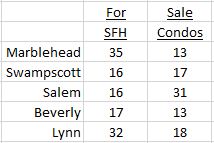
Click on these links for full details of each of the properties:
Marblehead SFHs For Sale
Marblehead Condos For Sale
Swampscott SFH For Sale
Swampscott Condos For Sale
Salem SFHS For Sale
Salem Condos For Sale
Beverly SFHs For Sale
Beverly Condos For Sale
Lynn SFHs For Sale
Lynn Condos For Sale
Why are Mortgage Rates Jumping?
Recession and Recovery
Andrew Oliver
Market Analyst | Team Harborside | teamharborside.com
REALTOR®
Sagan Harborside Sotheby’s International Realty
One Essex Street | Marblehead, MA 01945
m 617.834.8205
www.OliverReports.com
[email protected]
Sotheby’s International Realty® is a registered trademark licensed to Sotheby’s International Realty Affiliates LLC. Each Office Is Independently Owned and Operated
Housing Inventory continues to shrink
Single Family Homes (SFH)
After years of decline, the number of Single Family Homes (SFH) for sale in Essex County on the first of the month compared with a year earlier (YOY) increased from August 2018 until June 2019. Since then the decline has resumed, as this table shows:
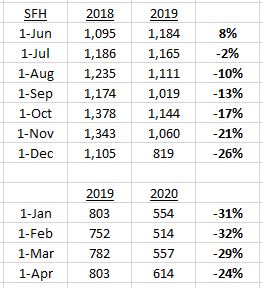
The next two charts (the first for January to June; the second July to December) show the number of SFHs for sale on the first of the month since 2017. In the first chart the numbers for 2020 YOY show the renewed decline (in 2019 inventory was increasing until June). (more…)
New Listings week ending March 20
There is still a lot of activity in the local market. With few if any Open Houses please call to schedule a private showing for these New Listings: (more…)
Why are Mortgage Rates Jumping?
Regular readers of this column are aware of the link between the 10-year Treasury (10T) and the 30-year Fixed rate Mortgage(FRM). Over the last several years the spread – the difference between FRM and the yield on 10T has averaged around 1.75% (see table below). So with the 10T yielding 1.15% the FRM should be say 2.9%. Right?
Wrong. Today’s Freddie Mac weekly survey, taken on Monday-Wednesday this week, showed an average rate of 3.65%, up from 3.36% last week and the all-time low of 3.29% recorded two weeks ago.
Why is that? The simple answer is Supply and Demand, a basic economic equation I have been applying to the housing market in recent years. While simple, this is a fundamental of understanding markets – whether for housing, mortgage rates – or toilet paper.
In recent years there have been more buyers – Demand – than sellers – Supply- in the housing market, and this has led to bidding wars and rising prices. In my Recession and Recovery piece I wrote that the imbalance between Sellers and Buyers was quite likely to change in the coming weeks, as some buyers hold off and more sellers come forward.
My hope is that this will lead to a more balanced market when conditions stabilise.
Coming back to mortgage rates, in my Mortgage rates Stabilise post last Saturday I wrote: “Lenders are overwhelmed by refinancing requests and are keeping rates up to slow demand.”
In other words, Demand is exceeding Supply and prices are rising.
I under-estimated the degree to which the quoted mortgage rate would rise in the short-term. This was Freddie Mac’s comment today: “Mortgage rates rose again this week as lenders increased prices to help manage skyrocketing refinance demand. This is expected to be a short-term phenomenon as lenders work through their backlog.”
And here is a very short video from Bankrate explaining what has been going on this week: Why aren’t mortgage rates lower?”.
The table below shows the spread over the last 15 years. Noe that in a previous time of stress – 2008/09 (although for a very different reason) the spread widened before reverting to the mean when conditions stabilised.

I expect the same phenomenon to occur again in due course.
I’ll end with the same Wall Street Journal quote I used to end one of my earlier posts:
“For all the foreboding about the novel coronavirus—foreboding that is justified—it is heartening to see the American people responding in ways reminiscent of the frontier spirit. Most people are doing what they have to do to survive a clear and immediate threat to their lives and communities.”
And I ended: “And that spirit will also determine that the recovery will come.”
As it shall.
Andrew Oliver
REALTOR®
Sagan Harborside Sotheby’s International Realty
One Essex Street | Marblehead, MA 01945
m 617.834.8205
www.OliverReports.com
[email protected]
Sotheby’s International Realty® is a registered trademark licensed to Sotheby’s International Realty Affiliates LLC. Each Office Is Independently Owned and Operated
This is NOT Like the Last Time
Below is an article from Keeping Current Matters, highlighting the substantial differences between 2008 and today.
And here is a link to my recent post: Recession and Recovery
5 Simple Graphs Proving This Is NOT Like the Last Time

With all of the volatility in the stock market and uncertainty about the Coronavirus (COVID-19), some are concerned we may be headed for another housing crash like the one we experienced from 2006-2008. The feeling is understandable. Ali Wolf, Director of Economic Research at the real estate consulting firm Meyers Research, addressed this point in a recent interview:
“With people having PTSD from the last time, they’re still afraid of buying at the wrong time.”
There are many reasons, however, indicating this real estate market is nothing like 2008. Here are five visuals to show the dramatic differences.
1. Mortgage standards are nothing like they were back then.
During the housing bubble, it was difficult NOT to get a mortgage. Today, it is tough to qualify. The Mortgage Bankers’ Association releases a Mortgage Credit Availability Index which is “a summary measure which indicates the availability of mortgage credit at a point in time.” The higher the index, the easier it is to get a mortgage. As shown below, during the housing bubble, the index skyrocketed. Currently, the index shows how getting a mortgage is even more difficult than it was before the bubble.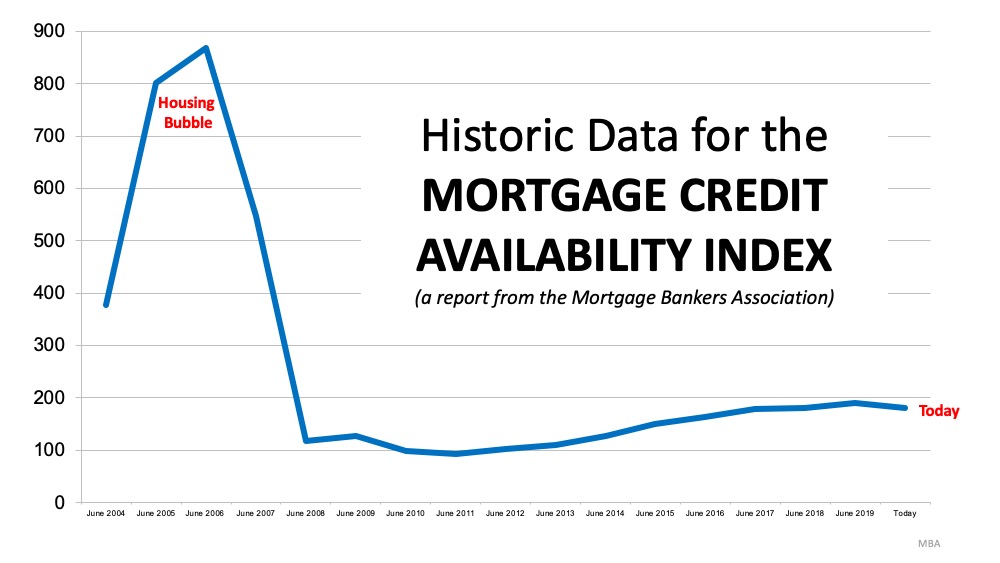
2. Prices are not soaring out of control.
Below is a graph showing annual house appreciation over the past six years, compared to the six years leading up to the height of the housing bubble. Though price appreciation has been quite strong recently, it is nowhere near the rise in prices that preceded the crash.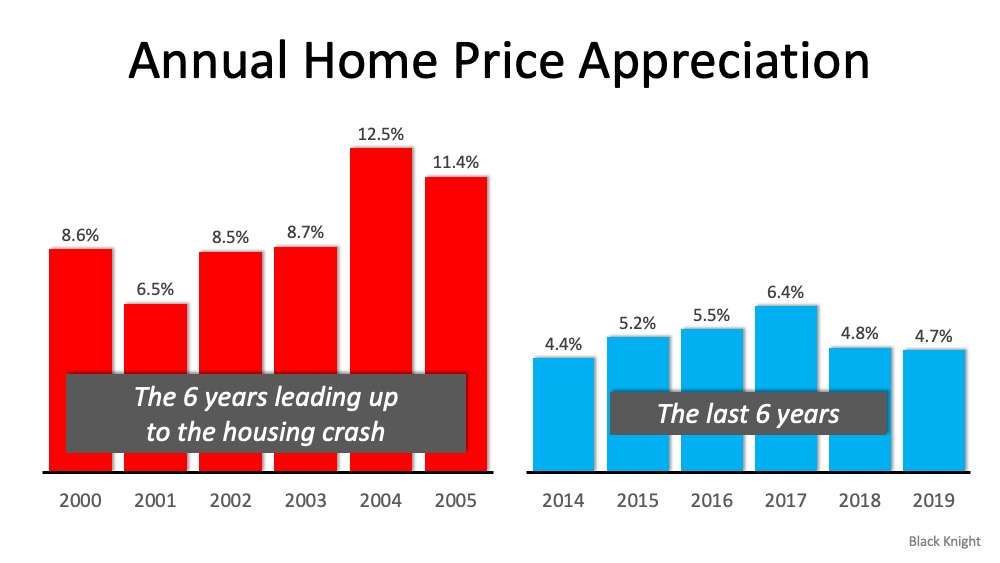 There’s a stark difference between these two periods of time. Normal appreciation is 3.6%, so while current appreciation is higher than the historic norm, it’s certainly not accelerating beyond control as it did in the early 2000s.
There’s a stark difference between these two periods of time. Normal appreciation is 3.6%, so while current appreciation is higher than the historic norm, it’s certainly not accelerating beyond control as it did in the early 2000s.
3. We don’t have a surplus of homes on the market. We have a shortage.
The months’ supply of inventory needed to sustain a normal real estate market is approximately six months. Anything more than that is an overabundance and will causes prices to depreciate. Anything less than that is a shortage and will lead to continued appreciation. As the next graph shows, there were too many homes for sale in 2007, and that caused prices to tumble. Today, there’s a shortage of inventory which is causing an acceleration in home values.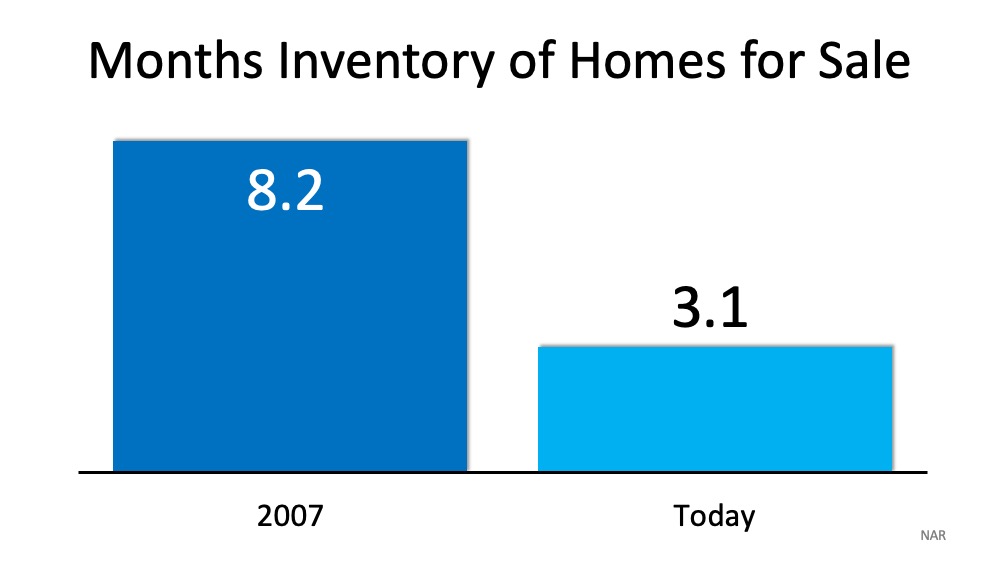
4. Houses became too expensive to buy.
The affordability formula has three components: the price of the home, the wages earned by the purchaser, and the mortgage rate available at the time. Fourteen years ago, prices were high, wages were low, and mortgage rates were over 6%. Today, prices are still high. Wages, however, have increased and the mortgage rate is about 3.5%. That means the average family pays less of their monthly income toward their mortgage payment than they did back then. Here’s a graph showing that difference:
5. People are equity rich, not tapped out.
In the run-up to the housing bubble, homeowners were using their homes as a personal ATM machine. Many immediately withdrew their equity once it built up, and they learned their lesson in the process. Prices have risen nicely over the last few years, leading to over fifty percent of homes in the country having greater than 50% equity. But owners have not been tapping into it like the last time. Here is a table comparing the equity withdrawal over the last three years compared to 2005, 2006, and 2007. Homeowners have cashed out over $500 billion dollars less than before: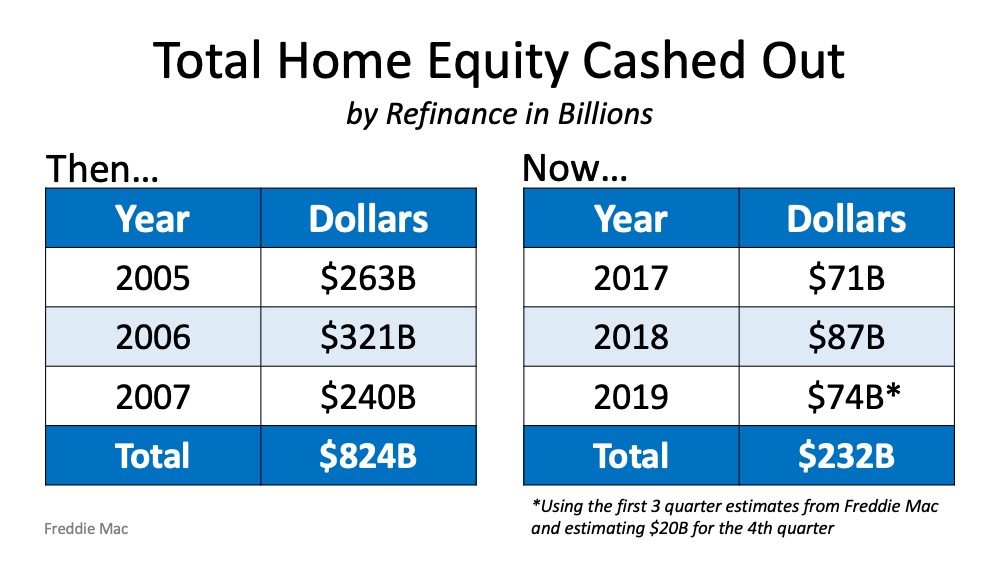 During the crash, home values began to fall, and sellers found themselves in a negative equity situation (where the amount of the mortgage they owned was greater than the value of their home). Some decided to walk away from their homes, and that led to a rash of distressed property listings (foreclosures and short sales), which sold at huge discounts, thus lowering the value of other homes in the area. That can’t happen today.
During the crash, home values began to fall, and sellers found themselves in a negative equity situation (where the amount of the mortgage they owned was greater than the value of their home). Some decided to walk away from their homes, and that led to a rash of distressed property listings (foreclosures and short sales), which sold at huge discounts, thus lowering the value of other homes in the area. That can’t happen today.
Bottom Line
If you’re concerned we’re making the same mistakes that led to the housing crash, take a look at the charts and graphs above to help alleviate your fears.
Mortgage rates after the collapse of bond yields
Andrew Oliver
REALTOR®
Sagan Harborside Sotheby’s International Realty
One Essex Street | Marblehead, MA 01945
m 617.834.8205
www.OliverReports.com
[email protected]
Sotheby’s International Realty® is a registered trademark licensed to Sotheby’s International Realty Affiliates LLC. Each Office Is Independently Owned and Operated
Recession and Recovery
Statistics tell us about the past, while markets look to the future. I have no doubt that the world will see negative growth in the second quarter and possibly the third quarter – which would make it officially a recession – but I also expect a strong recovery fueled by the amount of monetary and fiscal stimulus that has already been provided by some countries and will be by others.
Perhaps the best coordinated response so far has come from the UK where monetary, fiscal and regulatory measures were announced together on Wednesday. The US has been slow to acknowledge the seriousness of COVID-19 and the fiscal measures announced so far are, rightly, largely aimed at helping those most affected by the economic impact of the shutdown of so much of the country. I have to assume that a larger fiscal stimulus will be announced at some point.
As to the future I quote from a recent Wall Street Journal editorial:
“For all the foreboding about the novel coronavirus—foreboding that is justified—it is heartening to see the American people responding in ways reminiscent of the frontier spirit. Most people are doing what they have to do to survive a clear and immediate threat to their lives and communities.”
“The new watchword is “social distancing.” The speed with which the American people and their institutions are executing that sound strategy is breathtaking.”
“Health emergencies in the U.S. mainly and appropriately remain the responsibility of state and local officials.”
“The House package includes free testing for everyone who needs it, and two weeks of paid sick leave to allow people with the virus to stay home from work and avoid infecting co-workers. It also includes enhanced jobless benefits, increased food aid for children, senior citizens and food banks, and higher funding for Medicaid benefits.”
“The pandemic is still in its early stages in the U.S., and the fight will be a long haul. Social distancing by individuals and businesses may have to persist for weeks or even months. The good news on Friday is that the federal government and private economy seem at last to be manning the health barricades.”
China’s example
Perhaps lost in the drama of this week is the news that China seems to be on the path to returning to normal. On Friday Apple reopened all its 42 stores which had been closed since early February.
“It feels to me that China is getting the coronavirus under control,” CEO Tim Cook said in an interview two weeks ago. “I mean you look at the numbers, they’re coming down day by day by day. And so I’m very optimistic there.” Cook went on to point out that Apple’s suppliers were reopening factories.
Starbucks closed about half of its 4,300 stores on January 29. Those closures, combined with already planned closures for Chinese New Year holiday, resulted in some 80% of its stores shuttered in early February. As of early March more than 90% of its stores were open, albeit most were operating on a reduced schedule. By month’s end, assuming no unforeseen reoccurrences of the disease, the company expects 95% of stores in China to be open.
On March 9, Jing Daily reported that China may soon have the disease under control thanks to its proactive public health measures. And some analysts predict government-imposed quarantine measures may begin to lift as early as the end of March.
With the first quarter of 2020 in the tank, JP Morgan research analysts are hopeful for an economic recovery in the second quarter. According to China Daily, Jing Ulrich, the bank’s vice chairman of global banking and Asia-Pacific, predicts that the Chinese economy will grow 15% quarter-on-quarter from April to June, after contracting by 3.9% during the first three months of 2020, compared to the previous year.
Comment
The slow response to the seriousness of COVID-19 may delay the recovery in the US but that recovery should still take place later this year. The timing depends upon the success of the measures to contain the spread of the virus and the scale of the fiscal stimulus which is still to be announced.
As for the housing market, I have for some years used the simple concept of Supply and Demand to describe conditions. For some years Demand has far out-stripped Supply. It seems quite possible that for the next few months Demand may be reduced as buyers adopt a wait and see attitude, while Supply may increase as those sellers who had been thinking of selling decide to do so.
If this works out, we may later in the year see a more balanced housing market between buyers and sellers.
I will end this piece by repeating an earlier quote from the WSJ:L
“For all the foreboding about the novel coronavirus—foreboding that is justified—it is heartening to see the American people responding in ways reminiscent of the frontier spirit. Most people are doing what they have to do to survive a clear and immediate threat to their lives and communities.”
And that spirit will also determine that the recovery will come.
Mortgage rates after the collapse of bond yields
Coronavirus and the Housing Market: Part 2
Andrew Oliver
REALTOR®
Sagan Harborside Sotheby’s International Realty
One Essex Street | Marblehead, MA 01945
m 617.834.8205
www.OliverReports.com
[email protected]
Sotheby’s International Realty® is a registered trademark licensed to Sotheby’s International Realty Affiliates LLC. Each Office Is Independently Owned and Operated
Keep Calm and Carry On
This week the UK announced a coordinated package of monetary, fiscal and regulatory measures. As this article recalls, the UK continues its tradition of having quietly spoken professionals keep the public informed:
The quite heroes standing up in our time of crisis provides a timeline of stoical British reaction to crises.

It is important to remember, in the words of the Persian adage: “this too shall pass.”
Andrew Oliver
REALTOR®
Sagan Harborside Sotheby’s International Realty
One Essex Street | Marblehead, MA 01945
m 617.834.8205
www.OliverReports.com
[email protected]
Sotheby’s International Realty® is a registered trademark licensed to Sotheby’s International Realty Affiliates LLC. Each Office Is Independently Owned and Operated
New Listings mid-week March 11
Here are the most recent New Listings:

Marblehead New Listings
Swampscott New Listings
Salem New Listings
Beverly New Listings
Lynn New Listings
and click New Listings to search in other towns.
Click on these links for details:
Mortgage rates after the collapse of bond yields
Coronavirus and the Housing Market: Part 2
Will house prices continue to rise in 2020?
Are You Thinking of Selling in 2020?
Swampscott homeowners: now is a GREAT time to sell
Andrew Oliver
Market Analyst | Team Harborside | teamharborside.com
REALTOR®
Sagan Harborside Sotheby’s International Realty
One Essex Street | Marblehead, MA 01945
m 617.834.8205
www.OliverReports.com
[email protected]
Sotheby’s International Realty® is a registered trademark licensed to Sotheby’s International Realty Affiliates LLC. Each Office Is Independently Owned and Operated
New Listings week ending March 6
Here are the week’s New Listings:

Marblehead New Listings
Swampscott New Listings
Salem New Listings
Beverly New Listings
Lynn New Listings
and click New Listings to search in other towns.
Click on these links for details:
Mortgage rates after the collapse of bond yields
Coronavirus and the Housing Market: Part 2
Will house prices continue to rise in 2020?
Are You Thinking of Selling in 2020?
Swampscott homeowners: now is a GREAT time to sell
Andrew Oliver
Market Analyst | Team Harborside | teamharborside.com
REALTOR®
Sagan Harborside Sotheby’s International Realty
One Essex Street | Marblehead, MA 01945
m 617.834.8205
www.OliverReports.com
[email protected]
Sotheby’s International Realty® is a registered trademark licensed to Sotheby’s International Realty Affiliates LLC. Each Office Is Independently Owned and Operated
Mortgage rates after the collapse of bond yields
Somewhat to the surprise of markets, the Federal Reserve (Fed) lowered its Fed Funds Rate (FF) this week by 0.5% to 1.25%, in response to the rapidly developing, coronavirus-induced fear of an economic slump.
What does this mean for mortgage rates? First, I will explain the link – or lack of link – between FF and FRM- and what actually drives mortgage rates. This is easier than predicting what will happen going forward, but for what it is worth I offer some thoughts at the end of this piece.
Five charts explain the factors driving mortgage rates. In all cases the numbers are at the dates that the Fed has changed its FF over the last 4 years: 10 increases, followed by four decreases.
Fed Funds rate (FF)
The Fed Fund rate is the rate at which banks lend to each other overnight.
After increasing from 0% to 2.5% since late 2015, cuts in 2019 and 2020 have lowered the rate to 1.25%.
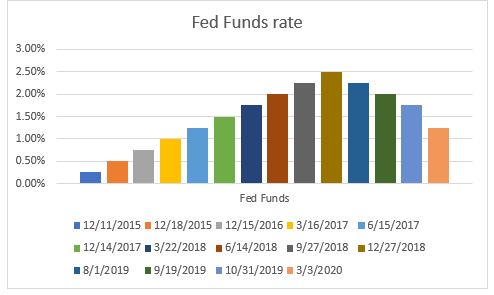
30-year Fixed Rate Mortgage (FRM)
The FRM reached nearly 5% in late 2018 and dropped to an all-time low this week of 3.29%.
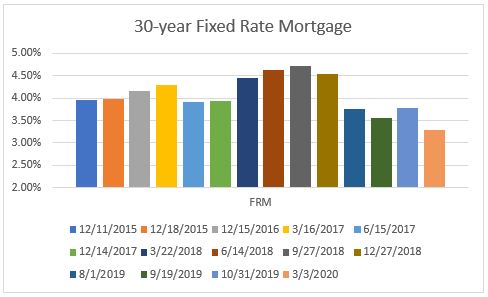
10-year Treasury yield (10T)
The yield on the 10T is influenced by two major factors: the outlook for the economy (expanding businesses invest creating demand for money) and geopolitical events – the US dollar and US Treasuries are seen as a safe haven during times of uncertainty.
The yield reached 3.2% in November, 2018 (which was the time of the peak in the FRM), but in the last two weeks the yield has plummeted from around 1.5% to 0.74% on Friday.
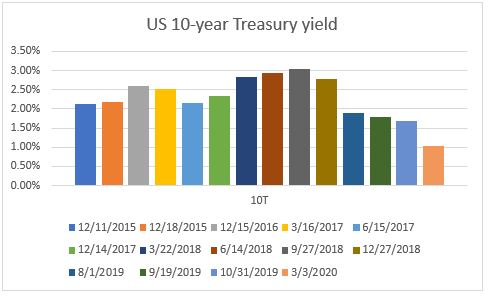
The spread, or difference, between FRM and FF
If there were a link between FF and FRM it would show up in this chart. In fact, the spread dropped from 3.7% in 2015 in 2019 before increasing to 2.0% recently, demonstrating that there is no direct link between FF and FRM
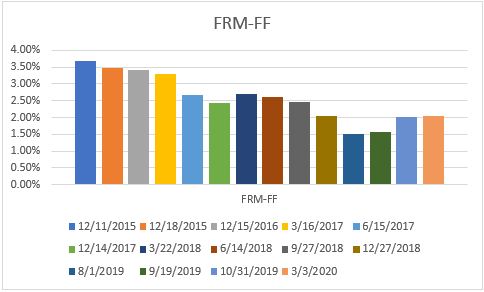
The spread, or difference, between FRM and 10T
We see more consistency between FRM and 10T, where the spread has, until recently, been in a much tighter range of 1.5% to 1.8%.
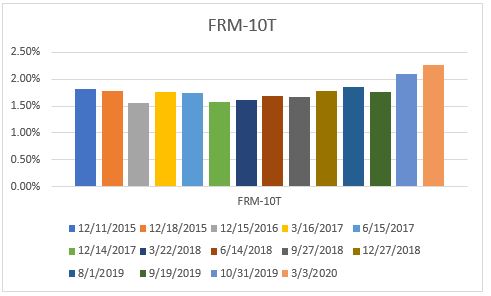
Indeed, over the last several years the spread has been very stable averaging around 1.7%. But I would point out two things in this table: first, the spread widened significantly in the great recession in 2008; and, secondly, while the median spread for the year has been in a narrow range, within the years there have been quite wide variations – in particular look at 2008/2009.
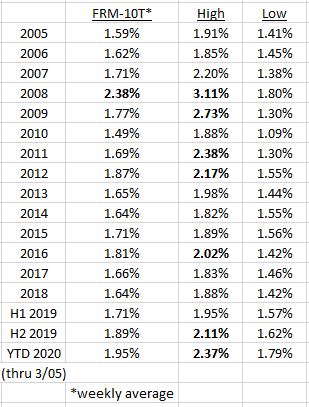
Comment
The FF rate affects the lending rate for credit cards, auto loans, adjustable rate mortgages, all of which are impacted by banks’ Prime Rate, which moves with the FF rate. Fixed Rate Mortgages – the typical 30-year mortgage – have a longer life and their benchmark is the closest Treasury security, which is the 10T. Conventional mortgages are bundled and sold to investors, who require a risk premium – higher yield – over that offered by 10T.
As can be seen, that premium – spread – has been remarkable constant over recent years. It does fluctuate from time to time – as the yield on 10T tends to move quickly at times, although never before as quickly as in the last two weeks – but in recent years has always comes back to around that 1.7% level.
Here are a few thoughts about the current situation:
1. Nobody knows how severe the coronavirus will prove to be, but there seems to be a good chance that many sectors of the world economy will see an abrupt slump, rather than a gradual slowdown.
2. The hope is that the crisis stage of COVID-19 will pass quite quickly and that this will be followed by a rapid recovery in economic activity.
3. But nobody knows.
4. In times of crisis countries need strong political leadership, reassuring the public that, while serious, all possible action is being taken to confront the situation. The response has varied country to country, but we must hope that there will be a more coordinated effort in the very near future.
Mortgage rates
As the last table showed, whereas over time the spread between FRM and 10T has been consistent in the 1.7% range, there have been wide variations in the short-term. We saw that in 2008 and 2009, a time of great economic duress when widespread buying of US Treasuries as a safe haven drove yields down and spreads widened. Those spreads returned to the norm as economic conditions improved.
The current economic situation is very different from the Great Recession. Indeed, but for COVID-19 the extremely strong employment numbers announced yesterday would lead to expectations that the Fed would be increasing rates; instead, the market is expecting another cut.
But as many commentators have pointed out, lower interest rates will not overcome health concerns. For example, lower rates will not make people travel.Money is cheap and plentiful – what is lacking right now is demand. It is a time for fiscal measures not monetary ones.
Another factor is the demand for mortgage-backed securities, the bundles of mortgages sold to investors. In the Great Recession, investors were wary about the value of the underlying security – residential mortgages – and so demanded a larger premium. That should not be a concern now with housing markets remaining very strong.
So will mortgage rates get to 3%, a number raised in my Are mortgage rates headed to 3%? article last June.
My best guess – and at this stage it is a guess – is that in time, when we know the extent of the economic slump and the pace of recovery, interest rates will raise again.Could the FRM reach 3%? Yes. Will it? Ask me again in a couple of weeks.
Andrew Oliver
Market Analyst | Team Harborside | teamharborside.com
REALTOR®
Sagan Harborside Sotheby’s International Realty
One Essex Street | Marblehead, MA 01945
m 617.834.8205
www.OliverReports.com
www.TeamHarborside.com
[email protected]
Sotheby’s International Realty® is a registered trademark licensed to Sotheby’s International Realty Affiliates LLC. Each Office Is Independently Owned and Operated
Open Houses weekend March 7/8
Here are this weekend’s Open Houses, shown in date order. As always, an updated list will be published at 8 a.m. on Sunday.

Click on these links for details:
Marblehead Open Houses
Swampscott Open Houses
Salem Open Houses
Beverly Open Houses
Lynn Open Houses
and click Open Houses to search in other towns.
Mortgage rates after the collapse of bond yields
Will house prices continue to rise in 2020?
Are You Thinking of Selling in 2020?
Swampscott homeowners: now is a GREAT time to sell
Andrew Oliver
Market Analyst | Team Harborside | teamharborside.com
REALTOR®
Sagan Harborside Sotheby’s International Realty
One Essex Street | Marblehead, MA 01945
m 617.834.8205
www.OliverReports.com
[email protected]
Sotheby’s International Realty® is a registered trademark licensed to Sotheby’s International Realty Affiliates LLC. Each Office Is Independently Owned and Operated
Housing market inventory shrinks even further in March
Single Family Homes (SFH)
After years of decline, the number of Single Family Homes (SFH) for sale in Essex County on the first of the month compared with a year earlier (YOY) increased from August 2018 until June 2019. Since then the decline has resumed and, in fact, accelerated, as this table shows:
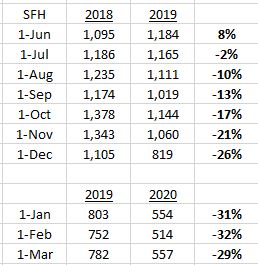
The next two charts (the first for January to June; the second July to December) show the number of SFHs for sale on the first of the month since 2017. In the first chart the numbers for 2020 YOY show the renewed decline (in 2019 inventory was increasing until June).
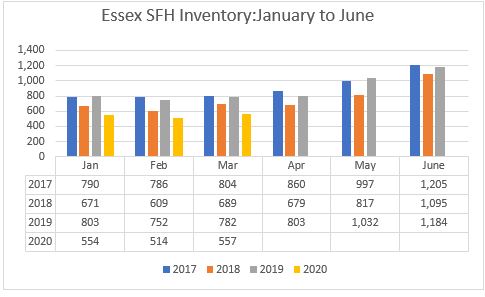
The second chart shows the decline YOY each month from July to December in 2019.
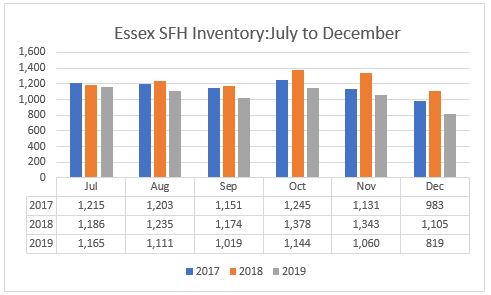
Condos
The number of condos for sale increased YOY from June 2018 until August 2019, but since then there has been a decline, which has also accelerated in recent months:
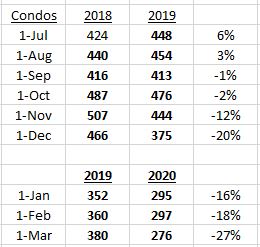
These two charts show numbers since 2017 for January to June, and July to December.
The first chart shows the decline in 2020 YOY, while in 2019 inventory was increasing in the first 6 months of the year.
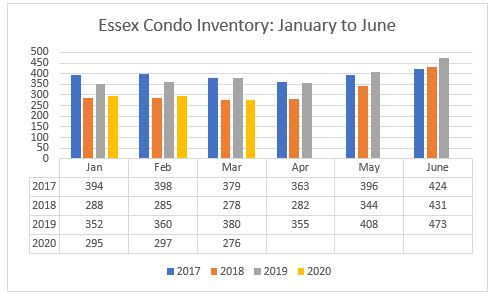
The second chart shows inventory continuing to increase in 2019 YOY in July and August, steadying in September, and then resuming the decline in October.
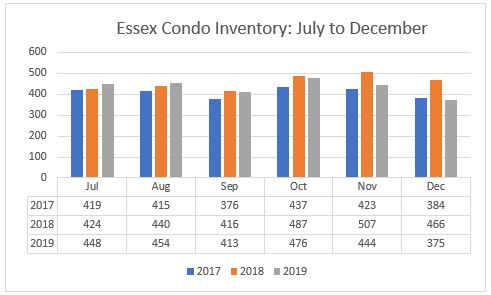
Comment
While the overall supply of SFHs in Essex County remains very low at just 1.5 months ( a market has traditionally been considered to be in equilibrium between buyers and sellers when there is 6 months of supply) the position varies widely by price, as shown in this table:
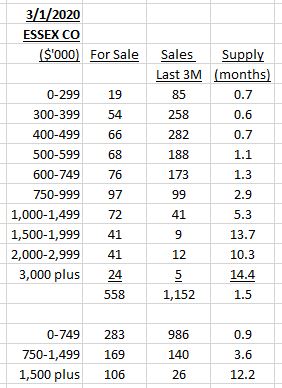
While inventory early in the year is normally low, a feature of 2020 so far is the speed at which new listings, if priced appropriately, are selling. If you are thinking of selling, now is a really good time.
The conclusion remains that the market remains in favour of sellers right up to $1.5 million, but above that dramatically swings in favour of buyers.
Mortgage rates after the collapse of bond yields
Will house prices continue to rise in 2020?
Are You Thinking of Selling in 2020?
Swampscott homeowners: now is a GREAT time to sell
Andrew Oliver
Market Analyst | Team Harborside | teamharborside.com
REALTOR®
Sagan Harborside Sotheby’s International Realty
One Essex Street | Marblehead, MA 01945
m 617.834.8205
New Listings mid-week March 4
Here are the most recent New Listings:

Marblehead New Listings
Swampscott New Listings
Salem New Listings
Beverly New Listings
Lynn New Listings
and click New Listings to search in other towns.
Coronavirus and the Housing Market: Part 2
Will house prices continue to rise in 2020?
Are You Thinking of Selling in 2020?
Swampscott homeowners: now is a GREAT time to sell
Andrew Oliver
Market Analyst | Team Harborside | teamharborside.com
REALTOR®
Sagan Harborside Sotheby’s International Realty
One Essex Street | Marblehead, MA 01945
m 617.834.8205
www.OliverReports.com
[email protected]
Sotheby’s International Realty® is a registered trademark licensed to Sotheby’s International Realty Affiliates LLC. Each Office Is Independently Owned and Operated
Coronavirus and the Housing Market: Part 2
Three weeks ago I published Coronavirus and the housing market concluding with this comment: While it is too early to forecast the impact of the coronavirus, world stock markets this week suggest that investors believe it will be limited beyond the short term. And meanwhile, ultra low mortgage rates only exacerbate the impact of the extreme low level of supply in the housing market.
Well that changed this week!
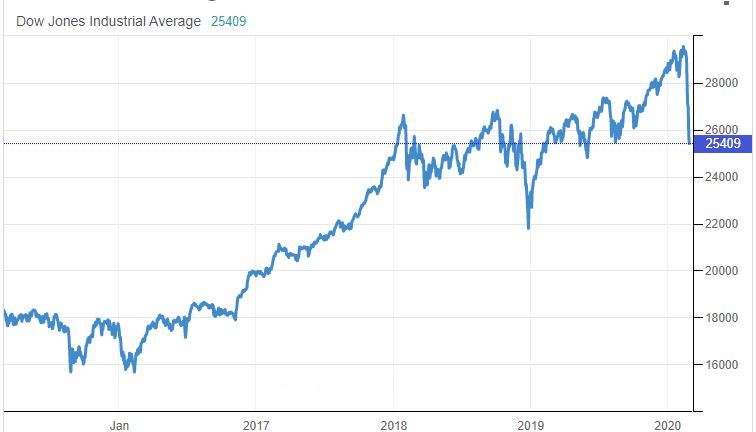
It is worth remembering that for some time commentators have been observing that the stock market was at extended valuations but that nobody wanted to sell, so maybe coronavirus was the excuse for the “overdue” stock market correction to occur.
Which is not to underestimate the significance of the crisis as it seems likely to impact everything from air travel and tourism to concert attendance; from manufacturing supply lines to decisions about future supply markets. At this stage, we simply do not know.
The most important factor for both the economy and the housing market is consumer confidence. The University of Michigan survey of Consumer Sentiment for February edged up 1.2 points to 101.0, the highest level since March 2018. The accompanying commentary said:”The coronavirus was mentioned by 8% of all consumers in February when describing the reasons for their economic expectations. However, on Monday and Tuesday of this week—the last days of the February survey—20% mentioned the coronavirus due to the steep drop in equity prices as well as the CDC warnings about the potential threat of the virus.”
What we do know is that mortgage rates have dropped even further. The Freddie Mac weekly survey published on Thursday showed the national average 30-year Fired Rate Mortgage at 3.45% and that rate seems likely to drop further next week.
The US economy continues to show steady, if unspectacular grow. Provided coronavirus just delays economic activity, that will continue to be the story. A longer slowdown may well lead the world into a recession but it really is too early to tell.
Meanwhile the story of recent years continues to apply: Record low inventory + record low mortgage rates + strong demand = rising home prices.
Will house prices continue to rise in 2020?
Are You Thinking of Selling in 2020?
Swampscott: now is a GREAT time to sell
Andrew Oliver
Market Analyst | Team Harborside | teamharborside.com
REALTOR®
Sagan Harborside Sotheby’s International Realty
One Essex Street | Marblehead, MA 01945
m 617.834.8205
www.OliverReports.com
[email protected]
Sotheby’s International Realty® is a registered trademark licensed to Sotheby’s International Realty Affiliates LLC. Each Office Is Independently Owned and Operated

Recent Comments